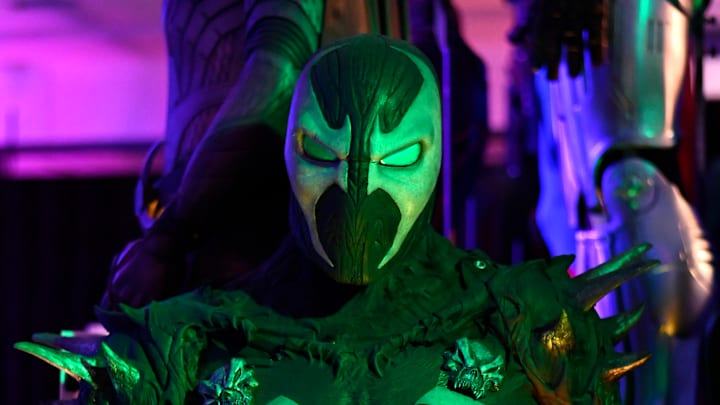Created by Todd McFarlane, Spawn was originally published by the newly formed Image Comics in 1992, before going on to become one of the bestselling independent comic series of all time. The series focuses on former special forces agent Al Simmons, who was betrayed and murdered before being resurrected as a demonic being known as a Hellspawn. Bestowed with otherworldy abilities but still possessing a strong moral compass, Simmons, who comes to be known as Spawn, becomes the protector of humanity against the forces of darkness as an inevitable war between Heaven and Hell starts to manifest.
Because the comic was so successful, a film adaptation of Spawn was inevitably released by New Line Cinema in 1997. Directed by Mark A.Z. Dippé, a former Industrial Light & Magic staffer who worked on the visual effects for Terminator 2: Judgment Day and Jurassic Park, the film was simply titled Spawn, and it starred Michael Jai White as Spawn, with a supporting cast including John Leguizamo, Martin Sheen, Theresa Randle, Nicol Williamson, and D. B. Sweeney. Despite being a modest financial success, grossing $87 million worldwide against a budget of $40 million, Spawn received negative reviews from critics. Regardless, it was still a fun and entertaining adaptation which wisely did not take itself too seriously.
Strangely, the film’s visual effects were handled by multiple companies, which is why there was a very clear level of inconsistency with the effects which appeared onscreen. One of the main companies that worked on the film was Industrial Light & Magic, which comes as no surprise, since director Dippé had a history there. ILM was founded by George Lucas in 1975, before going on to create the effects for the original Star Wars film, which was released in 1977 and later won an Oscar for Best Visual Effects. ILM then went on to create the special effects for the other Star Wars films and countless other blockbusters, becoming one of the most renowned and respected visual effects companies of all time.
For Spawn, ILM animated Spawn’s flowing cape and the demonic monster known as the Violator, which battles Spawn in an alleyway. In his human form, the Violator resembles a sinister clown (played by John Leguizamo), before transforming into his monstrous alter ego at the start of the fight. The transformation looks impressive even by today's standards.
The effects that ILM created for Spawn looked absolutely incredible for the time, with the VFX company pushing the boundaries of digital technology to bring Violator and Spawn’s cape to life. Violator looks as realistic as any of the dinosaurs in Jurassic Park, which ILM won an Oscar for, and Spawn’s cape, which flows, moves, and expands as though it were alive (MacFarlane also created Venom for Marvel Comics, and Spawn’s cape moves and reacts to its surrounding very similarly to the alien Symbiote), seemed so lifelike that it felt like it was going to burst through the screen at any second. Put simply, ILM did a spectacular job on Spawn.
Why did Hell look so bad in Spawn?
However, because of budgetary constraints, ILM did not create the film’s depiction of Hell. Instead, the scenes taking place in Hell were outsourced to various other VFX companies, with the most notable being Santa Barbara Studios, who finished working on the film after just six weeks.
Hell looked infamously terrible in Spawn, with tremendously fake lava and fiery textures and laughably bad rocky pillars that looked like they had been taken straight from a cheap PS1 game. And the gigantic demon known as Malebolgia, who serves as the film’s main antagonist, was animated so poorly that it was impossible to find him threatening or intimidating, as he resembled a low-resolution model which the animators had forgotten to add any texture to. We also saw waves of other terribly animated Hellspawn warriors standing on rock platforms in Hell, who literally looked like they had been copied and pasted into the shots in which they appeared, never actually seeming like they were part of the environment or like they were really present in any capacity.
Even by the standards of 1997, the scenes in Spawn that take place in Hell looked laughably bad, which is very unfortunate when you take into account how great the other effects in the film were. Another company called Banned from the Ranch created some decent effects for the film, but neither their work nor ILM's was enough to make viewers overlook the visually awful scenes in Hell.
As a result of the effects in the film being handled by different studios, the visuals in Spawn looked inconsistent, to say the least. And had it not been for the awfully animated scenes in Hell, the film would probably have received an Oscar nomination for Best Visual Effects due to the spectacular work by Industrial Light & Magic.
However, regardless of the very noticeable differences in visual effects throughout the different scenes, Spawn is still a very enjoyable film which offers plenty of entertainment value to viewers without asking them to think too hard. The film was released on 4K Blu-ray earlier this year, so you should certainly track it down if you have not done so already.
